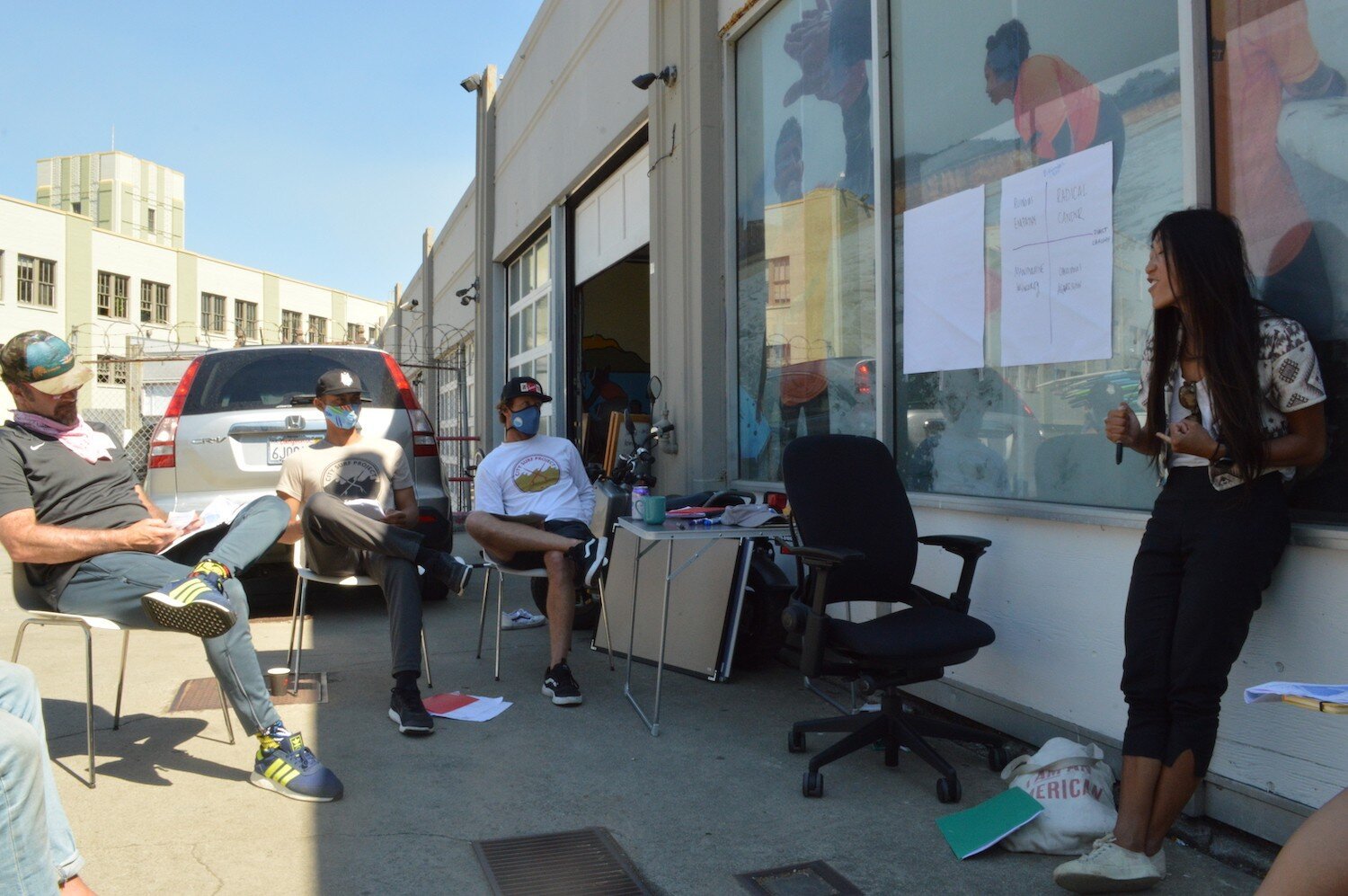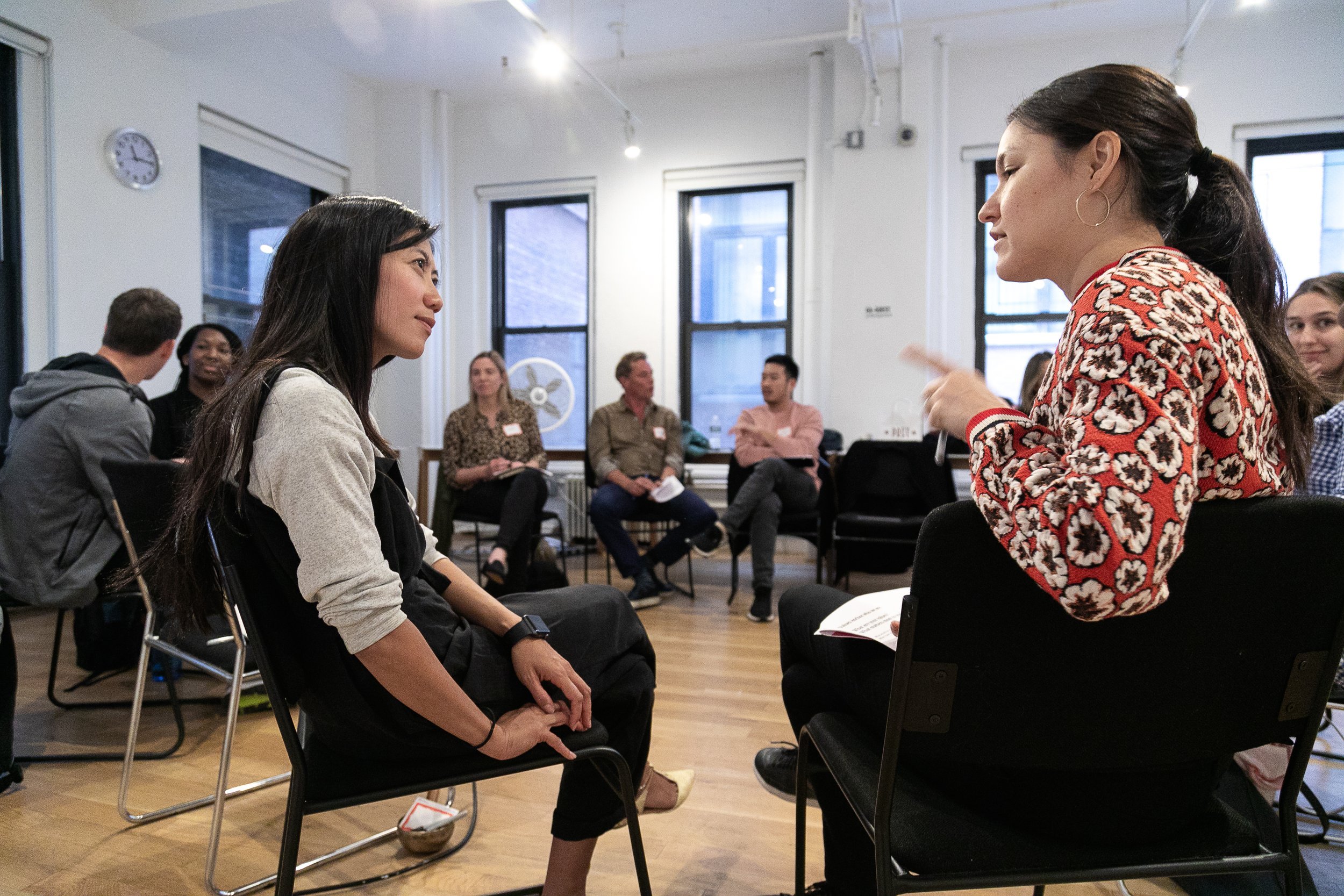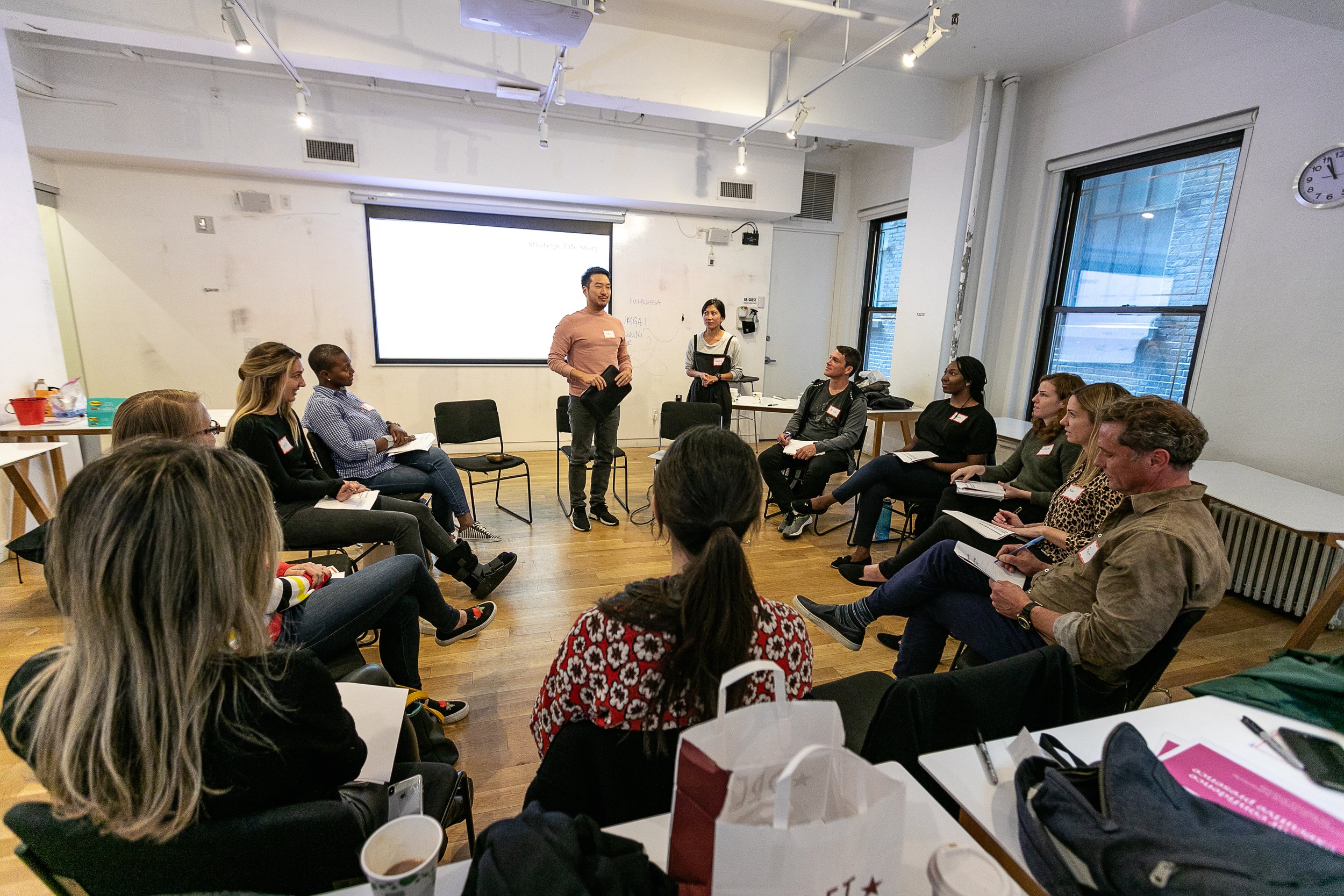How to Facilitate Skillful Group Conversations amidst Difficult Political Events
All-staff retreat for the Bay Area-based nonprofit City Surf Project
San Francisco: August 2020
Photo by Meghan Hannebutt
Since the onset of the Pandemic, one of the most common things I get asked as a DEI & Mental Health Consultant is how do I hold compassionate conversations on difficult political events -- whether that be the most recent Supreme Court overturn of Affirmative Action, war in Ukraine or the impending 2024 US presidential elections.
We were socialized into the belief that the workplace should be ‘neutral’, not ‘personal’ certainly not ‘political’. Yet, COVID-19 indelibly changed our relationship to political events within the workplace; leadership avoidance and silence can create employee harm and impact retention, even amidst an economic downturn. Many employers are stumbling to find an authentic and psychologically safe way to talk about the hard things that impact our work lives and mental health.
One my strategic consulting DEI & Mental Health partners Dr. Bree McDaniel shared this data from the American Psychological Association (2021), “Rates of anxiety [28.2%-37.2%] and depression [20.2%-31.1%] among U.S. adults were about 4 times higher between April 2020 and August 2021, than they were in 2019.” When we ignore what is happening in our external world, it impacts our internal world.
Community and emotional safety has been my obsession since I was 15 years old, when I began my journey as a youth community organizer and mental health crisis volunteer in Seattle.
Public Meetup on How to Change the World following the election of Trump
London: December 2016
Photo by Melissa Arras
Below is a pragmatic hypothesis in eight steps on how you might approach this challenge, based on my work facilitating 1000+ DEI and leadership development workshops for 100+ organizations across identities, geographics, political lines, over the course of my lifetime:
Co-create an intention for the conversation
Recruit 2-3 experienced internal or external facilitators to ‘hold the space’
Make the intention and boundaries of the ‘safe space container’ clear in your company communication
Share Community Agreements at the beginning of your group conversation
Begin conversation with an ice breaker or community warmer
Provide powerful open questions to spur meaningful discussion and action
Close with individual and collective next steps
Provide emotional aftercare
1
Co-create an intention for the conversation
I am often astonished by the hubris of employers who come into these conversations with no strategy or agenda yet expect their employees to leave feeling seen and heard. Or, the opposite: too afraid to even start the conversation.
Workshop at General Assembly on Confidence & Authentic Leadership
New York City: September 2019
Photo by Jesse Whiles
Begin with compassionate and thoughtful intention.
Who is this for? What do they need? What are you hoping to achieve? And why?
Host a pre-conversation with your co-facilitators and co-leaders to uncover your core intention.
Intention Example 1: Psychological Safety & Retention
A safer space to simply support our employees of color in authentically sharing how they are feeling about the overturn of Affirmative Action and the impact on their personal and professional lives.
Intention Example 2: Psychological Safety, Retention & Organizational Action
An organizing space to discuss what actions your senior leadership can proactively take to respond to the overturn of Affirmative Action.
2
Recruit 2-3 experienced internal or external facilitators to ‘hold the space’
These conversations require deep thoughtfulness and emotional acumen and can cause harm if they aren’t approached skilfully. When we are facilitating conversations on political events that employees can experience as painful, we are potentially entering into the realm of political trauma.
Workshop on Designing the Life You Want
Siargao, Philippines: January 2020
Photo by Bren Stormin
I recently attended a trauma-informed yoga teacher training run by therapist and somatic experiencing practitioner Hala Khouri, who defines trauma as, “Anything that overwhelms our capacity to cope and respond, and leaves us feeling helpless, hopeless and out of control.”
Building on Khouri’s definition of systemic trauma, I define political trauma as an experience of feeling helpless, hopeless and out of control, caused by unequal access to resources based on race, gender, sexual identity, ability, class, religion, etc.
The overturn of Roe versus Wade could be interpreted as an expression of politicized sexism. The overturn of Affirmative Action could be interpreted as an expression of politicized racism. These are forms of political trauma, therefore, these conversations require trauma-sensitive facilitation.
Ideally, you’d have two facilitators to co-guide the conversation and co-center the room, particularly if difficult feelings or tension arises, and a third facilitator to support with 1:1 care in case someone needs more personalized support or as a supplementary person to small group discussion. Facilitation casting is super critical as you’re thinking about how you’re going to nourish safety in the room.
3
Make the intention and boundaries of the ‘safe space container’ clear in your company communication
Here’s hypothetical communication you might share with your team, adjust accordingly to meet the needs of your people and organization:
“We're here to have a compassionate team conversation (no more than 20 people) on the recent overturn of Affirmative Action and how we can strategically support equitable and diverse recruitment in our organization.”
“To acknowledge the overturn of Roe v. Wade, we'd like to host a small group conversation (no more than 12 people) over lunch on how you feel about this recent overturn and how we can continue to foster a culture of equity and inclusion.”
“To continue to build on Pride Month, we'd like to host an all-company conversation on the anti-trans legislation spurring across the country and how we can support the LGBTQ2IA+ communities at work.”
4
Share Community Agreements at the beginning of your group conversation
Sharing Community Agreements helps nourish emotional and psychological safety, the foundation of a high-performing team.
Workshop at The New York Times on Authentic Leadership
New York City: September 2019
Photo by Jesse Whiles
In preparation for your conversation, design the 'group container' for the organizational culture you’re seeking to manifest at scale. The ‘group container’ acts as a role model for what might be possible in terms of new workplace futures -- or what writer and activist adrienne maree, calls a ‘fractal’, the smallest unit of what might be possible at scale. In other words, we have to embody the change we want to sit at scale by even just starting with one person, one workshop: ourselves.
“In a fractal conception, I am a cell-sized unit of the human organism, and I have to use my life to leverage a shift in the system by how I am, as much as with the things I do. This means actually being in my life, and it means bringing my values into my daily decision making.”
-adrienne maree brown
Highlight key agreements that address key cultural changes or challenges (e.g. people not used to listening, being vulnerable or being open to different perspectives) you want to change.
What might be those ‘fractal’ changes?
Example Community Agreements
Open mind and heart. Active listening. Come to our group space with the willingness to truly be present and open to different perspectives and stories.
Take space, make space. If you tend to speak less, take space. If you tend to be the first to speak, make space. Be mindful who's speaking, not speaking. What might be the words left unsaid?
Mistakes may happen. Have grace and compassion. An invitation to have grace and compassion for folks in the room, knowing we all come with different life experiences, identities and perspectives.
5
Begin conversation with an ice breaker or community warmer
Before getting into heavier content and discussion, nourish a sense of safety and community.
What’s your name?
What are your pronouns? [You can explain the importance of sharing pronouns if this is not a common practice in your organization — and how it is a practice of honoring the humanity of each person in the room and showing solidarity with the LGBTQ2IA+ community].
How are you feeling in one word? [This is a more advanced embodied practice: You can invite each to embody their word with a freestyled gesture if they feel comfortable and get everyone in the room to mirror that gesture. For example, my word might be ‘love’ and my embodied gesture might be a ‘self hug’].
What is bringing you joy? What is your intention for today?
You can invite folks to share in pairs or small groups to build more personalized safety before doing a large group share.
Workshop at General Assembly on Confidence & Authentic Leadership
New York City: September 2019
Photo by Jess Whiles
As a yoga teacher and somatic practitioner, I like to start my workshops by inviting people to ground through a 1-2 minute meditation. The purpose of this practice is to support clients in letting go of anxiety and stress and getting present with the people in the room. The word ‘meditation’ can be polarizing, so you can say ‘grounding exercise’ with an invitation to close their eyes or gaze softly at the ground, gently relax their body and take a minute to sit in silence to connect to their intention for showing up to the group conversation. You can invite people to slowly stretch or intuitively move after the meditation.
6
Provide powerful open questions to spur meaningful discussion and action
Example questions
How do you feel after the recent Supreme Court overturn of Affirmative Action? What does this mean for you personally?
Drawing on radical empathy and compassion, what do you think led to this decision?
What would you like to do personally to nourish a culture of equity and inclusion?
What would you like us to do as a team / organization to nourish a culture of equity and inclusion?
Workshop at Groundfloor on Pride & Wellbeing
Oakland: June 2023
Photo by Gillian Stargensky
Invite folks to silently journal, draw or reflect before joining small or large group conversation for 5-7 mins. After self reflection, you can encourage people to get in small groups of 2-3 to share their reflections for 10-12 mins. There's always a right to pass, just listen or sit quietly off to the side. Capture key themes in a Google Doc if you're virtual or big sticky notes if you're in person.
7
Close with individual and collective next steps
All-staff retreat for the Bay Area-based nonprofit City Surf Project
San Francisco: August 2020
Photo by Meghan Hannebutt
Invite folks to close with silent individual reflection:
Example questions
What is one key learning?
What one key action you want to take?
If you have time, you can ask each person in the room to share, or if you're running shorter on time, you can ask for 2-3 individual shares in the large group. After the group share out, you can can share collective next steps as co-facilitators and co-leaders.
Example commitments and actions
“After this session, we plan to take your learnings and actions to the senior leadership team.”
“After this lunch-time conversation, we're planning to make a collective donation to Trans Women of Color Collective.”
“We invite you to volunteer with us to help get out the vote for the 2024 Elections.”
8
Provide emotional aftercare
Workshop at Groundfloor on Pride & Wellbeing
Oakland: June 2023
Photo by Gillian Stargensky
This is an important step many leaders miss - and I’ve learnt this lesson unfortunately also the hard way, as both a facilitator and participant. No matter how skillfully facilitated, some folks may get triggered, feel emotionally overwhelmed and underresourced, and may need extra support after the session. Notice who may need more compassionate attention and provide emotional aftercare through 1:1 coaching conversations.
You also can offer resources to find values-aligned therapists, coaches and somatic practitioners alongside internal and external affinity groups.
In conclusion
There are many more practices for facilitating compassionate and safer spaces. It’s a constant practice of learning. If you’re just beginning your journey at the organization, remember it’s better to show up imperfectly, than not at all. Be honest about where you are on your facilitation journey -- and don’t be afraid to seek support.
How do you want to grow as
a facilitator and space holder?
If you’d like to deepen your DEI leadership, join us on September 15, 2023 for an intimate, in-person workshop in New York City on Embodied Inclusive Leadership.
You can get in touch with Mel for a 1:1 conversation on how to facilitate safer space conversations at your workplace.









